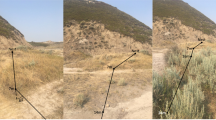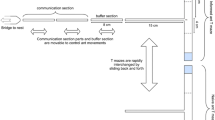Summary
-
1.
Scout ants ofFormica fusca lay a hindgut trail from the newly discovered food source to the nest; however, the hindgut material does not have a recruitment effect on nestmates.
-
2.
Inside the nest the recruiting ant performs a waggle motor display and food offerings when facing nestmates head-on. Nestmates are alerted by this behavior and subsequently follow the trail to the food source.
-
3.
Experiments have shown that neither Dufour's gland secretions nor poison gland substance can release trail following behavior. Only ants stimulated by the recruitment performance of the scout ant would follow the hindgut trail. Orientation experiments demonstrated that the hindgut trail serves as an important orientation cue during foraging activities.
-
4.
Also during nest emigrations recruiting ants lay chemical trails with hindgut contents, and again it could be demonstrated that the trails function only as orientation cues. Also in this case the alerting signal consists of a specific motor display. During nest emigrations most of the recruits, however, are carried to the target area by only a relatively small number of so-called “transporting specialists.”
-
5.
The recruitment technique employed byFormica fusca, in regard to its organizational level, can be placed between “group recruitment” on the one side and “chemical mass communication” on the other.
-
6.
Although the comparative analysis of the organizational levels of recruitment techniques employed by different formicine species does not necessarily provide direct evidence of the evolutionary pathways of recruitment behavior, it at least allows us to develop a model of the evolutionary steps leading to the highly sophisticated stage of mass communication.
Zusammenfassung
-
1.
Wenn Kundschafter vonFormica fusca eine neue Futterquelle entdeckt haben, markieren sie den Weg von der Futterquelle zum Nest mit Rektalblaseninhalt. Diese Enddarmspur allein hat jedoch keinen stimulierenden Effekt auf die Nestgenossen.
-
2.
Im Nest zeigt die werbende Kundschafterin ein spezifisches Wackelverhalten und Futteraustauschverhalten, wenn sie Nestgenossen begegnet. Dadurch werden die Ameisen stimuliert, das Nest zu verlassen und entlang der Enddarmspur zur Futterquelle zu laufen.
-
3.
Versuche haben gezeigt, daß weder das Sekret der Dufourschen Drüse noch das der Giftdrüse Spurfolgeverhalten auslöst. Nur wenn die Ameisen durch das spezifische Werbeverhalten der Kundschafterin stimuliert wurden, folgen sie der Enddarmspur. Orientierungsversuche bewiesen, daß die Spur ein wichtiges Orientierungssignal darstellt.
-
4.
Auch bei Nestumzügen legen Kundschafter und Werber eine Spur vom neuen zum alten Nest. Aber auch in diesem Falle dient die Spur nur zur Orientierung, whährend die Nestgenossen wiederum durch ein spezielles Rekrutierungsverhalten stimuliert werden. Die meisten Nestgenossen werden jedoch zum neuen Nestplatz getragen, wobei nur wenige Tragespezialisten beteiligt sind.
-
5.
Der Rekrutierungsmechanismus vonFormica fusca steht in Bezug auf seine organisatorische Stufe zwischen „Gruppenrekrutierung“ und „chemischer Massenkommunikation.“
-
6.
Wenn auch die Ergebnisse der vergleichenden Analyse der Rekrutierungsweisen von Formicinae nicht unbedingt direkte Hinweise zur Evolution von Werbesignalen bei Ameisen liefern, so bieten doch die gefundenen unterschiedlichen Organisationsstufen ein sinnvolles Modell, mit dem der Evolutionsweg zur hoch entwickelten „chemischen Massenkommunikation“ bei Ameisen erklärt werden kann.
Similar content being viewed by others
References
Ayre, G. L.: Comparative studies on the behavior of three species of ants (Hymenoptera: Formicidae). II. Trail formation and group foraging. Canad. Entomologist101, 118–128 (1969)
Batschelet, B.: Statistical methods for the analysis of problems in animal orientation and certain biological rhythms. AIBS Monograph, American Institute of Biological Sciences (1965)
Blum, M. S., Wilson, E. O.: The anatomical source of trail substances in formicine ants. Psyche (Cambridge)71, 28–31 (1964)
Büttner, K.: Untersuchungen über den Einfluß des Beutetieres auf den Erbeutungsvorgang bei der WaldameiseFormica polyctena Foerster (Hym. Formicidae). Z. angew. Entomol.74, 177–196 (1973)
Hangartner, W.: Spezifität und Inaktivierung des Spurpheromons vonLasius fuliginosus LATR. und Orientierung der Arbeiterinnen im Duftfeld. Z. vergl. Physiol.57, 103–136 (1967)
Hangartner, W., Bernstein, S.: Über die Geruchsspur vonLasius fuliginosus zwischen Nest und Futterquelle. Experientia (Basel)20, 392–393 (1964)
Hassenstein, B.: Ommatidenraster und afferente Bewegungsintegration. Z. vergl. Physiol.22, 119–145 (1951)
Hölldobler, B.: Recruitment behavior inCamponotus socius (Hym. Formicidae). Z. vergl. Physiol.75, 123–142 (1971)
Hölldobler, B.: Communication in social Hymenoptera. In: How animals communicate (ed. Th. A. Sebeok). Bloomington: Indiana University Press, in press, 1975
Hölldobler, B., Möglich, M., Maschwitz, U.: Communication by tandem running in the antCamponotus sericeus. J. comp. Physiol.90, 105–127 (1974)
Horstmann, K.: Untersuchungen zur Arbeitsteilung unter den Außendienstarbeiterinnen der WaldameiseFormica polyctena Foerster. Z. Tierpsychol.32, 532–543 (1973)
Jander, R.: Die optische Richtungsorientierung der Roten Waldameise (Formica rufa L.). Z. vergl. Physiol.40, 162–238 (1957)
Leuthold, R. H.: Recruitment to food in the antCrematogaster ashmeadi Mayr. Psyche (Cambridge)75, 334–350 (1968)
Maschwitz, U.: Gefahrenalarmstoffe und Gefahrenalarmierung bei sozialen Hymenopteren. Z. vergl. Physiol.47, 596–655 (1964)
Möglich, M., Hölldobler, B.: Social carrying behavior and division of labor during nest moving in ants. Psyche (Cambridge)81, 219–236 (1974)
Möglich, M., Hölldobler, B., Maschwitz, U.:Camponotus sericeus (Formicidae), Tandemlauf beim Nestumzug. Encyclopaedia Cinematographica, E 2039, p. 3–18 (1974)
Rosengren, R.: Route fidelity, visual memory and recruitment behavior in foraging wood ants of the genusFormica (Hymenoptera, Formicidae). Acta zool. Fenn.133, 3–106 (1971)
Sudd, J. H.: Communication and recruitment in Pharaoh's ant,Monomorium pharaonis L. Anim. Behav.5, 104–109 (1957)
Szlep, R., Jacobi, T.: The mechanism of recruitment to mass foraging in colonies ofMonomorium venustum Smith,M. subopacum ssp.phoenicium Em.,Tapinoma israelis For. andT. simothi v.pnoenicium Em. Insectes Sociaux14, 25–40 (1967)
Szlep-Fessel, R.: The regulatory mechanisms in mass foraging and recruitment of soldiers inPheidole. Insectes sociaux17, 233–244 (1970)
Wallis, D. I.: Behavior patterns of the ant,Formica fusca. Anim. Behav.3, 1–13 (1962)
Wallis, D. I.: The foraging behaviour of the antFormica fusca. Behaviour23, 149–175 (1964)
Wilson, E. O.: Chemical communication among workers of the fire antSolenopsis saevissima (Fr. Smith). 1. The organization of mass-foraging. 2. An information analysis of the odour trail. 3. The experimental induction of social responses. Anim. Behav.10, 134–164 (1962)
Author information
Authors and Affiliations
Additional information
With support of NSF GB-38789 and Deutsche Forschungsgemeinschaft H0275/4.
We like to thank E. O. Wilson for reading the manuscript.
Rights and permissions
About this article
Cite this article
Möglich, M., Hölldobler, B. Communication and orientation during foraging and emigration in the antFormica fusca . J. Comp. Physiol. 101, 275–288 (1975). https://doi.org/10.1007/BF00657046
Received:
Issue Date:
DOI: https://doi.org/10.1007/BF00657046




